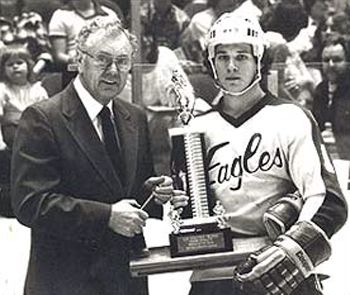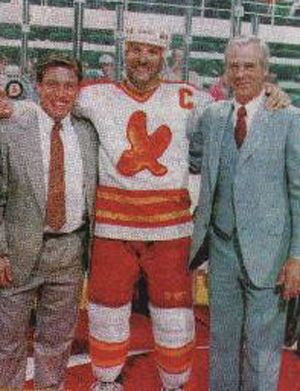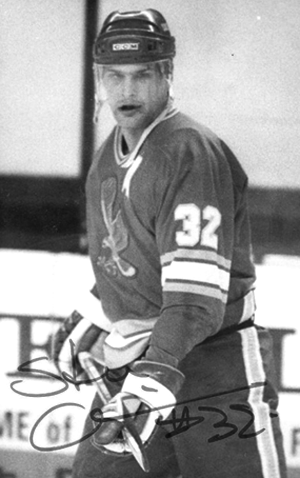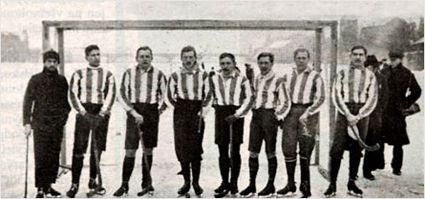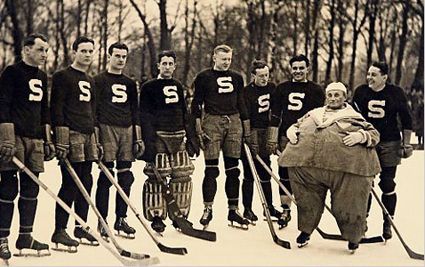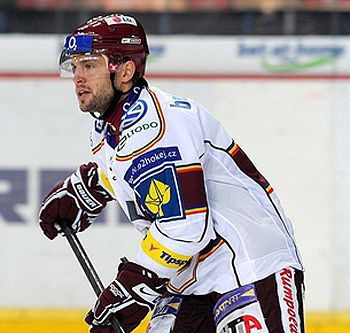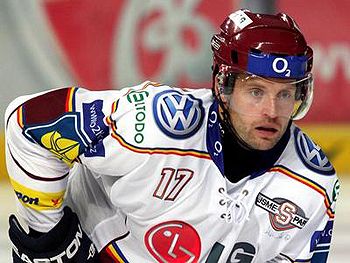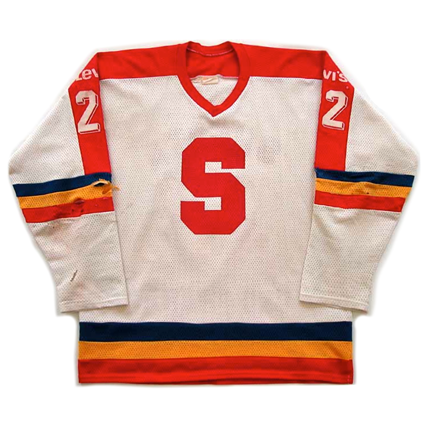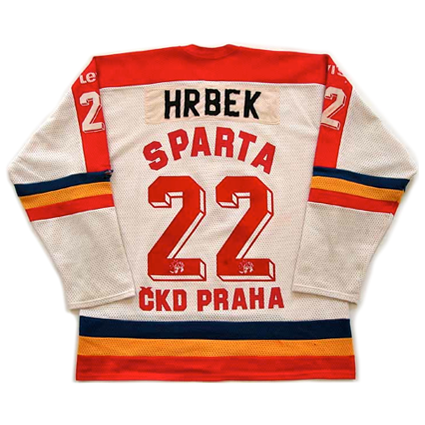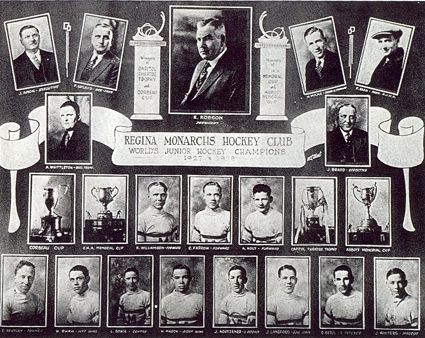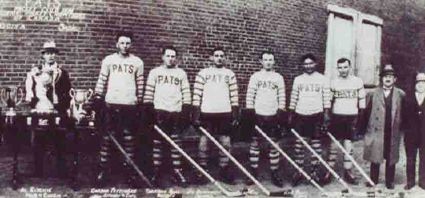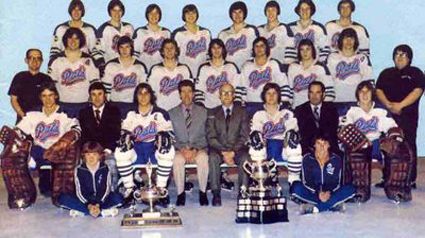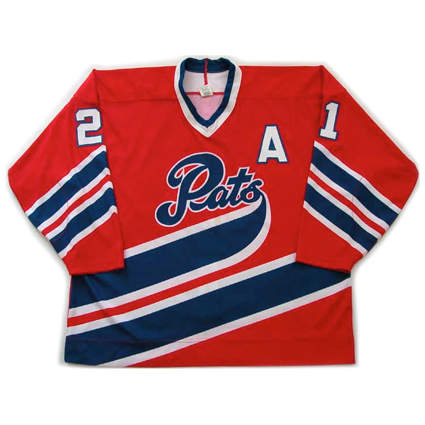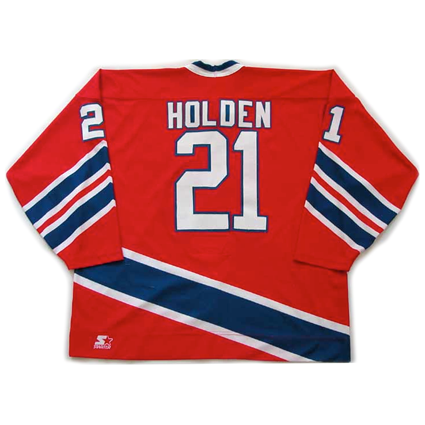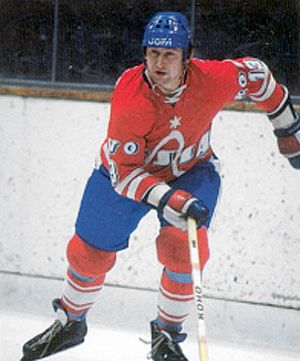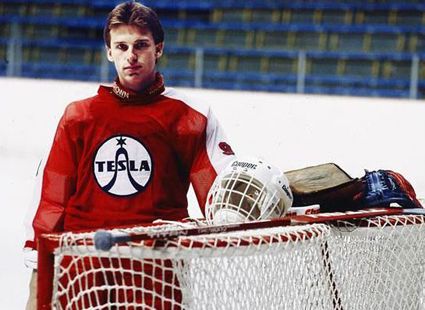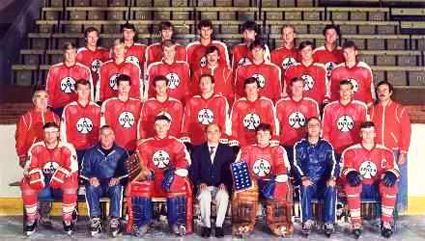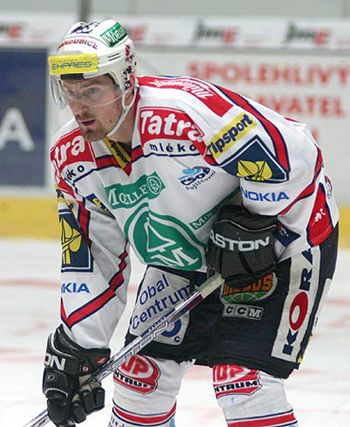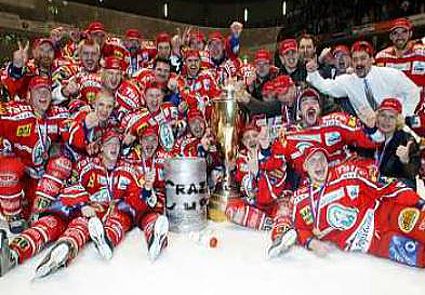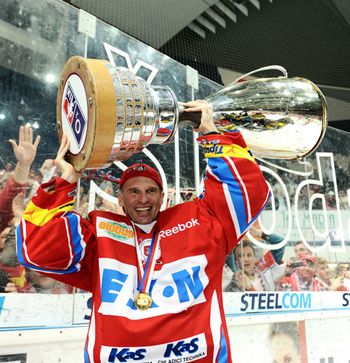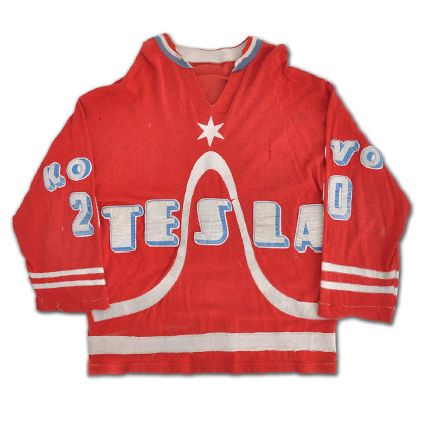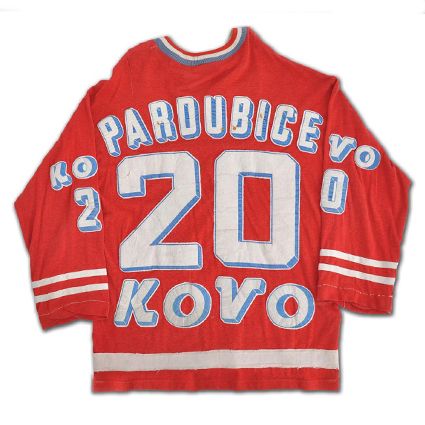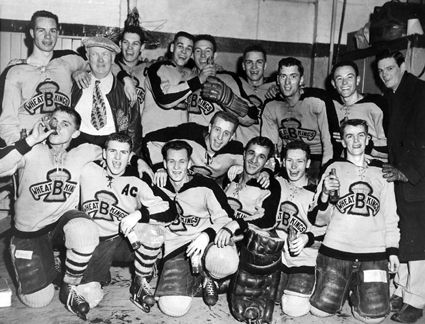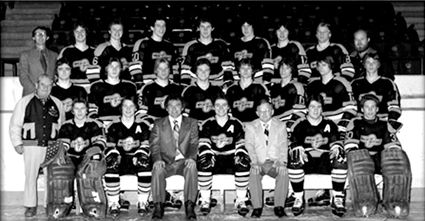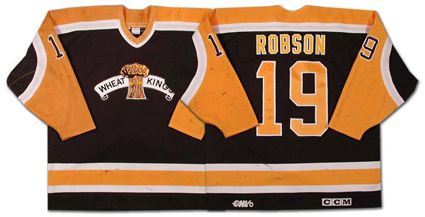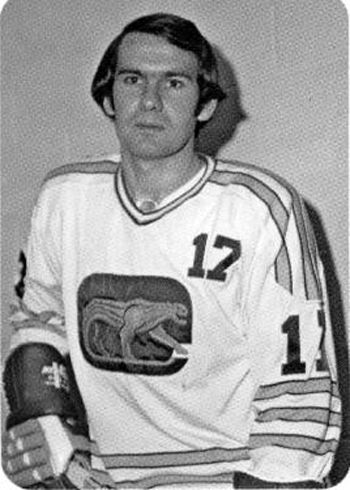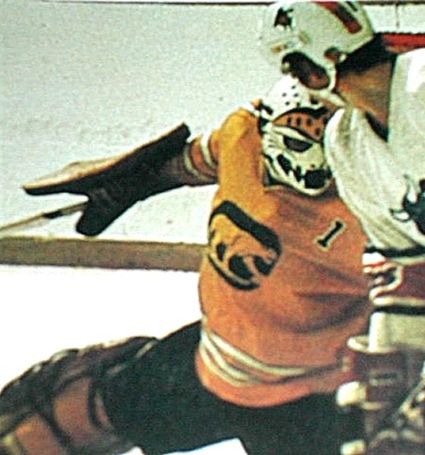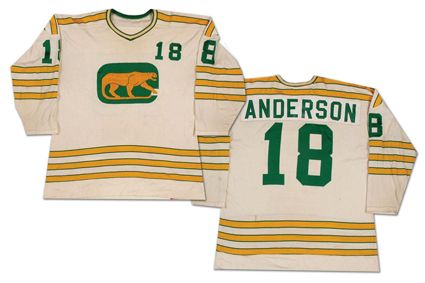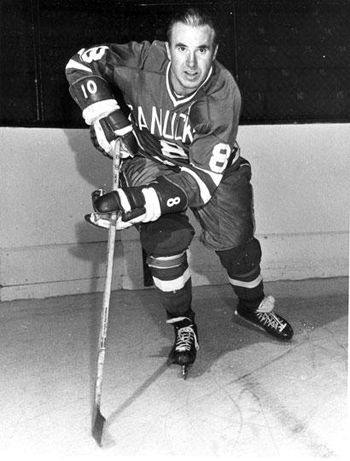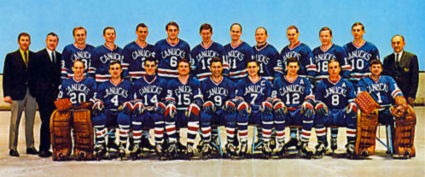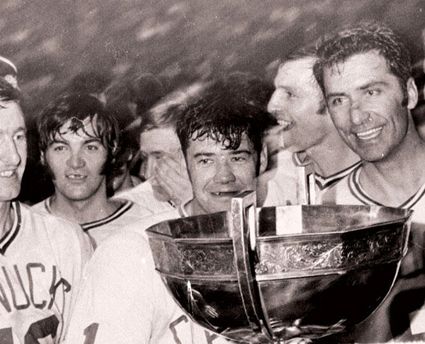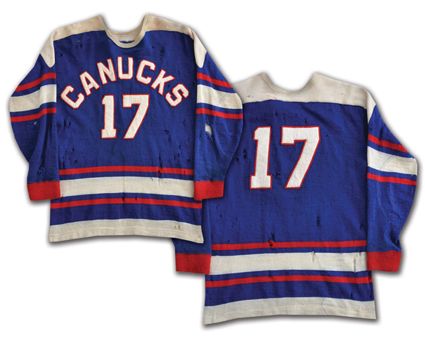Saturday, July 23, 2011
1969-70 Salt Lake Golden Eagles Art Quoquochi Jersey
July by the Numbers makes it's way to the Western United States for jersey #23.
While the Salt Lake Golden Eagles franchise had a stable run which spanned parts of four decades, the leagues the team was a member of changed with periodic regularity. The team was founded in 1969 as a member of the Western Hockey League. Two rough seasons as an expansion team followed with less than 20 wins. Still, their win totals increased every year for their first four seasons as members of the WHL.
For the 1974-75 season, the 22 year run of the WHL came to an end and the Golden Eagles joined the Central Hockey League and immediately finished first overall with a 43-24-11 record and won the Adams Cup by defeating the Dallas Black Hawks in overtime of Game 7 of the finals.
The Golden Eagles Doug Palazzari led the CHL in scoring in 1977-78 when he racked up 101 points in 70 games. The following season Salt Lake would finish first overall with a 47-22-7 mark and reach the finals once more.
In 1979-80 Salt Lake would again finish atop the league with 105 points after a 49-24-7 record with Palazzri having a career year after leading the CHL in goals (48), assists (61) and points with 109, 26 clear of his next closest competition. The Golden Eagles would capture their second Adams Cup by edging out the Fort Worth Texans 2-1 in Game 7 of the finals.
The Golden Eagles would win back-to-back titles following their success in 1980-81. Future NHL 500 goal scorer Joe Mullen led the league with 117 points that season and Salt Lake downed the Wichita Wind with the final series once again going the full seven games to determine the champion.
Joe Mullen accepts the CHL Rookie of the Year Award
After three more seasons without a losing record, the Golden Eagles once again outlived their league, as the CHL called it a day following the 1983-84 season. The Golden Eagles, along with the Indianapolis Checkers, chose to press on and found a home in the International Hockey League, a step up the ladder from the CHL.
While the team finished a few games under .500, Scott MacLeod led the IHL with 139 points in 82 games. The prolific MacLeod once again took the league scoring title in 1985-86, this time with 134 points.
Despite finishing with the fifth best record in the league in 1986-87, the Golden Eagles ousted the Milwaukee Admirals in Round 1 of the playoffs in six games and then knocked off the Fort Wayne Komets in five to reach the finals. There, they defeated the Muskegon Lumberjacks in six to capture the IHL's Turner Cup as Mike Rucinski's 27 playoff points in 17 games led the way.
The 1987-88 season was a virtual repeat of the previous season as the Golden Eagles finished with the sixth overall record but marched through three rounds of the playoffs, taking advantage of the top two favorites being upset in the opening round, to win their second consecutive Turner Cup in only their fourth season in the IHL.
The Golden Eagles reached the finals for the third consecutive season in 1988-89 following a franchise record, regardless of league, 116 point season after a 56-22-4 record.
Two seasons later Salt Lake again had a 50 win season in 1990-91 and were led in scoring by Rich Chenomaz for the third time in four years on his way to becoming the franchise's leading scorer during it's time in the IHL, as his 501 points easily lead MacLeod's 273.
Chenomaz, flanked by Palazzari and Lyle Bradley after Chenomaz set the all-time Golden Eagles scoring mark
The Golden Eagles fortunes took a downward turn, finishing with losing records the next three seasons, including missing the playoffs for the final two. Following their last place finish in 1993-94 after only 24 wins, the franchise was sold to interests from Detroit, who moved the team to Michigan and renamed it the Detroit Vipers for the 1994-95 season, bringing an end to the Golden Eagles after 25 seasons and five championships.
Notable players for the Golden Eagles throughout their history include Ernie Hicke and Wayne Rutledge from the WHL era, Jim Craig, Dirk Graham, Walt McKechnie, Mullen, Barclay Plager and Charlie Simmer from the CHL days and Derek Armstrong, Marc Bureau, Shane Churla, Theo Fleury, Stu Grimson, Trevor Kidd, Stephane Matteau, Jamie McLennan and Ziggy Palffy from the IHL days.
Future NHL enforcer Stu Grimson while with Salt Lake
Today's featured jersey is a 1969-70 Salt Lake Golden Eagles Art Quoquochi jersey from the very first season in franchise history. This jersey has several unique design elements, some of which were ahead of their time. While the twin stripes running down the arms are uncommon, the large blue cuffs are rather unique.
Other features that were ahead of it's time were the gold squares across the bottom rather than a single, solid stripe, and the vertical stripes up the sides would come into vogue in 2006 with the introduction of the Nike Swift jerseys as well as the Reebok Edge jerseys when they debuted in 2007.
All in all, a jersey that stands apart from the pack and holds up rather well over time.
Today's video highlight is some rare 8mm movie footage of the Golden Eagles taking on the San Diego Gulls from back in 1972.
Labels:
Salt Lake Golden Eagles
Friday, July 22, 2011
1993-94 Sparta Prague Petr Hrbek Jersey
July by the Numbers jersey #22 takes us to the capital city of Prague.
Founded before even the creation of Czechoslovakia, Sparta Praha (Sparta Prague) was originally formed back in 1893 as an athletic association and they first started playing bandy in 1903.
The Sparta Prague bandy team in 1907
They next ventured into forming an ice hockey team in 1909, making them as old as the Montreal Canadiens and older than every other team in NHL. Sparta eventually joined the First Czechoslovak League on it's creation in 1930.
The Sparta Prague hockey team in 1934 with some sort of unfortunate mascot
The team would capture their first championship in 1953 and immediately follow that up with a second consecutive title in 1954. Their next successes came outside of Czechoslovakia when they won the Spengler Cup in Switzerland in both 1962 and 1963.
It would take Sparta Prague until 1990 to win their third title, led by Jiri Dolezal team leading 58 points. Three seasons later, in 1993, Sparta would become the final champions of the First Czechoslovak League as Czechoslovakia then divided into the Czech Republic and Slovakia.
Jiri Dolezal
Following the split, Sparta would become members of the new Czech Extraliga and would be led to their first title in 1999-00 by team leading scorer David Vyborny, whose 63 points were second overall in the league.
David Vyborny
Two seasons later a 32-9-8 regular season record foretold of another playoff championship in 2002, led this time by Jaroslav Hlinka.
Jaroslav Hlinka
Their next title would arrive in 2006, which was a unexpected triumph considering their mid-pack regular season placing, sixth out of 14. Jan Marek led the Extraliga in scoring for Sparta with 54 points and Hlinka came through in the playoffs with 10 goals and 16 points in 17 games.
Sparta repeated their playoff success in 2006-07, once again led by Hlinka's league leading 57 points. Petr Ton tied Hlinka with 16 playoff points while leading the club with 11 goals in 16 games.
The club will once more be in the spotlight of the hockey world this fall when the host the New York Rangers on September 29, 2011 as part of the NHL Premier Challenge.
Today's featured jersey is a 1993-94 Sparta Prague Petr Hrbek jersey. This jersey was worn during the first season of the Czech Extraliga and features Sparta Prauge's iconic "S" logo on the chest, which is still free and clear of the coming wave of sponsorship that is soon to arrive in European hockey.
Unusually, it also has both the player name and the team name above the numbers on the back, with the team name radially arched, crowding the player name just that much more.
Today's video section features a quite dramatic promo video for Sparta Prague.
Labels:
Sparta Prague
Thursday, July 21, 2011
1997-98 Regina Pats Josh Holden Jersey
July by the Numbers jersey #21 takes us to Saskatchewan for the first time ever.
The oldest major junior team in the world, the Regina Pats were formed in 1917 and t heir original name was the Regina Patricia, after the military unit, Princess Patricia's Canadian Light Infantry, which was named after Princess Patricia of Connaught, granddaughter of Queen Victoria, and whose regimental crest is still worn on the shoulder of the club's jerseys.
The Patricias competed for the very first Memorial Cup in 1919 and again in 1922. In 1923 the team named was shortened to the Pats and two seasons later they won their first championship in 1925 with a 2 games to none win over Toronto Aura Lee. The club won their second title in 1928 when they were briefly known as the Regina Monarchs after merging with the Regina Falcons, with a 2 games to 1 win over the Ottawa Gunners.
1927-28 Memorial Cup champion Regina Monarchs
Their third title in six seasons came in 1930, after having to returned to being called the Pats, with a two game sweep of the West Toronto Nationals. The club made one more trip to the finals in 1933 prior to folding following the 1934-35 season.
1929-30 Memorial Cup champion Regina Pats
It would not be until 1946 that the Regina Pats would be resurrected when two junior teams, the Abbotts and Commandos merged to form a new organization, which became a farm team of the Montreal Canadiens and members of the newly created Saskatchewan Junior Hockey League, as the provence's hockey leagues had previously been divided into separate northern and southern leagues.
Only two seasons later, the Pats would join the Western Canada Junior Hockey League. It would not take the club long to attain success in the WCJHL, as they made their first appearance in the Memorial Cup final in 1950 and again in 1952, 1955 and 1956 after dominating the WCJHL, but agonizingly coming up short each time for the national title.
The club would rejoin the SJHL for 1957-58 and immediately return to the Memorial Cup Final, only to once again come up short. A new WCJHL was formed in 1966 and once again the Pats were on the move to a new league, which then changed it's name to the Western Canada Hockey League. Then, following a dispute over the upper age limit for junior players, the Pats left the WCHL for the SJHL for two seasons before the disputes were resolved and the Pats returned to the WCHL in 1970-71, but not before the Pats made the Memorial Cup in 1969.
The Pats captured the WCHL title in 1973-74, led in scoring by Dennis Sobchuk's 146 points in 66 games, followed by Clark Gilles 112 on their way to a 43-14-11 record. They finished the Round Robin portion of the schedule with a 1-1 record and advanced to the final thanks to their superior goal differential and then defeated the Quebec Remparts 7-4 to capture the first Memorial Cup since the team's rebirth 28 years earlier.
1973-74 Memorial Cup champion Regina Pats
The Pats have again made the Memorial Cup as the now renamed Western Hockey League champions in 1980 behind Doug Wickenheiser's league leading 89 goals and 170 points in 72 games.
The Pats most recent Memorial Cup appearance came in 2001 as hosts, where they fell in overtime of the semifinals.
Since the inception of the NHL Draft in 1963, Larry Wright became the first Pats player selected in the first round, when he was taken 8th overall by the Philadelphia Flyers in 1971. In 1974, Greg Joly became the first Pat ever taken first overall when he was selected by the Washington Capitals followed by Gilles 4th overall. Wickenheiser was the next Regina player taken #1 by Montreal in 1980.
Other first round players selected after playing for the Pats have been Garth Butcher (1981-10th), Mike Sillinger (1989 - 11th overall), Jason Smith (1992-18th), Jeff Friesen (1998-11th), Derek Morris (1996-13th), Brad Stuart (1998-3rd), and Calder Cup winner Barret Jackman (1999-17th). Other notable Pats have included Dirk Graham and Stu Grimson.
The Pats have retired seven numbers in honor of eight players, #1 for goaltender Ed Staniowski, #8 for Brad Hornung, #9 for Gilles, #12 for Wickenheiser, #14 for Sobchuk, #16 for the franchise's all-time leading scorer Dale Derkatch and Sillinger and #17 for Bill Hicke.
Today's featured jersey is a 1997-98 Regina Pats Josh Holden jersey. After a long history of classic jerseys, this style, made by Starter, suffers from the design excesses of the era, making for a loud and garish jersey, which thankfully did not last very long until a return to a more traditional style.
For a very in depth look at the history of the Regina Pats, please visit ReginaPatsHistory.com.
Labels:
Regina Pats
Wednesday, July 20, 2011
1975-76 Tesla Pardubice Jiří Novák Jersey
July by the Numbers returns to Eastern Europe for jersey #20.
HC Pardubice was formed in 1923 in Czechoslovakia. The club began to play a regular schedule of games in the early 1930's and at the end of World War II a new open air stadium with artificial ice arrived.
Shortly thereafter, the club won a second division title in 1949-50, earning promotion to the top level of Czech hockey, the Czechoslovak First Ice Hockey League. Since their promotion in 1950, they have remained without interruption at the top level of Czech hockey, a remarkable record of over 60 years of consistency and competitiveness.
On the occasion of their promotion in 1950-51, the club adopted a new name, Slavia Pardubice, which was then changed to Dynamo Pardubice for the 1953-54 campaign. The club set a new high water mark with a third place finish in 1959-60, the same season a roof was added to the stadium for the first time!
The club changed names once again due to a corporate sponsorship arrangement with Tesla, the government-owned electronics conglomerate, and thus became knows as Tesla Pardubice beginning in 1960-61.
In 1964-65, Zdeněk Špaček of Pardubice led the league in scoring with 33 goals. The club received an influx of talent from the 1967 Czechoslovak junior champions when Bohuslav Šťastný, Jiří Novák and Vladimír Martinec all joined the squad which paid off with their first ever league championship in 1972-73 following a first place regular season finish, coming from a 24-9-3 record, and a 4 games to 2 end the domination of six time defending champions Dukla Jihlava. Martinec was awarded the Golden Hockey Stick as the league MVP following the season, the first of four he would win over the next seven seasons.
Vladimír Martinec
That championship earned Pardubice a place in the following season's European Champions Cup, outlasting 15 other clubs to reach the final against the dominant Central Red Army Club of Moscow, Soviet Union, who had won the last five cups in a row. Pardubice defeated Red Army in Game 1 by a score of 3-2 at home, but fell in the second game 6-1 in Moscow for an 8-4 aggregate score for the Soviets.
In December of 1977, Pardubice came to North America and played four exhibition games against clubs from the NHL, losing 6-1 to the Philadelphia Flyers , defeating the Minnesota North Stars 4-2 and then losing to the Detroit Red Wings 5-4 and the New York Islanders 8-3.
In 1978-79, Martinec won his third MVP award, following previous ones in 1975 and 1976, when he led the league with 42 goals.
Two seasons later saw the arrival of Czech hockey legend and Pardubice native, goalkeeper Domink Hašek, who later became the club's number one netminder in 1982-83.
Hašek guided Tesla to the league championship in 1986-87 and 1988-89, winning the Golden Hockey Stick on both occasions. Also winning an award for Best Coach, was former star player Martinec.
1986-87 league champions Tesla Pardubice
With the many political changes in the world in the early 1990's, including the overthrow of the communist government in 1989, the club acquired a new name for the 1991-92 season when they became known as HC Pardubice.
Pardubice became members of the Czech Extraliga following the division of Czechoslovakia into the Czech Republic and Slovakia in 1993. The club has changed names several times since 1995 through a series of sponsorships.
The club rose to the top again, reaching the final in 2003-04 and winning their fourth championship in 2004-05, taking advantage of the opportunity to employ Jan Bulis, Milan Hejduk and playoff MVP Ales Hemsky during the NHL lockout.
Milan Hejduk
2004-05 champions HC Pardubice
Following his retirement from the NHL in 2008, Hašek returned to his roots and signed a one year contract with Pardubice for the 2009-10 season, going 23-10 on his way to leading the club to it's fifth and most recent championship at the age of 44.
Domink Hašek celebrates another championship on his return to him hometown of Pardubice
Today's featured jersey is a 1975-76 Tesla Pardubice Jiří Novák jersey. The front is dominated by the Tesla electronics company logo which makes for a striking jersey unlike any other. The jersey is customized in the classic Czech style of of the era with a small drop shadow and even smaller outline on both the letters, numbers and sponsorship logos.
Novák played for Pardubice from 1967 to 1970 and again from 1972 to 1981. His #20 has since been retired by the club, one of nine such honored sweaters in team history.
Today's video segment is Pardubice winning their most recent championship in 2010.
This next video is a slide show highlighting the fans of Pardubice, showing their passion for the club.
Labels:
Tesla Pardubice
Tuesday, July 19, 2011
1997-98 Brandon Wheat Kings Ryan Robson Jersey
July by the Numbers returns to Canada for jersey #19.
Founded in 1936 as a member of the Manitoba Junior Hockey League, the Brandon Wheat Kings competed in the MJHL for two seasons prior to changing their name to the Brandon Elks for two seasons, which included winning the MJHL championship and the Turnbull Cup in 1938-39.
Following a five year hiatus for World War II, the club returned to the ice for the 1945-46 season as well as returning to the name Wheat Kings to reflect the agricultural nature of their surrounding community in western Manitoba. The club quickly found their stride, winning championships in 1947, 1949 and 1950. They also went on to capture the 1949 Abbott Cup as champions of all of western Canada after defeating the Calgary Buffaloes.
After competing for four more seasons through 1953-54, the club once again went dormant for four seasons from 1954-55 to 1957-58.
The 1953-54 Brandon Wheat Kings
Similar to their previous break during World War II, the Wheat Kings returned with a vengeance. After a third place finish in 1958-59, Brandon reeled off five consecutive first place finishes and converted that dominance into four league playoff victories in five tires, winning titles in 1960, 1962, 1963 and 1964, after a regular season record of 27-1-2! During their five year period of MJHL dominance, the Wheat Kings posted a combined record of 132-34-7.
After three more seasons in the MJHL, the Wheat Kings joined the Western Hockey League for the 1967-68 season where they found life a lot harder going, as it was not until ten seasons for them to achieve a first place regular season finish, all without any playoff success.
The 1976-77 club was led by the trio of Bill Derlago (a WHL record 96 goals and 178 points), Ray Allison (137 points) and Brian Propp (135 points) who took the top three places in the WHL scoring race. They repeated their first place finish in 1977-78 with Propp taking the scoring title with 182 points, but it all really came together in 1978-79 when the Wheat Kings set not only a WHL record, but a Canadian Hockey League (encompassing both the Ontario Hockey League and Quebec Major Junior Hockey League as well) with a stellar 58-5-9 record for 125 points. Propp set the all-time franchise record, as well as setting a new WHL single season scoring record, with 194 points to take his second straight scoring title, 39 points clear of second place teammates Allison (153 points) and Laurie Boschman (149 points).
The 1978-79 Brandon Wheat Kings
Brandon went on to capture the Ed Chynoweth Cup as WHL playoff champions, which earned them a place in the Memorial Cup. While the Wheat Kings finished first in the round robin portion, they lost in the final 2-1 in overtime.
The Wheat Kings fell into a down period with 13 seasons with only one finish above 5th and eight seasons out of the playoffs. The highlight of this era was the 1983-84 season when Ray Ferarro set a WHL record with 108 goals on his way to a league scoring title with 192 points. Cam Plante also set an all-time league record with 140 points for a defenseman that same season.
Beginning in 1992-93, the Wheat Kings rebounded with back-to-back second place finishes before a trio of first place finishes from 1995 to 1997 and another Memorial Cup appearance in 1995 and a playoff championship and subsequent Memorial Cup appearance in 1996.
Five seasons later they were back on top once again for three of the next four seasons (2002, 2003 and 2005), but playoff success eluded them each time. In 2004-05 a trio of Wheat Kings again led the WHL in scoring - Eric Fehr (111 points), Ryan Stone (99 points) and Tim Konsorada (87 points).
Since then the Wheat Kings have managed a pair of first place finishes in 2006-07 and 2009-10, a season during which they also hosted the Memorial Cup and were able to reach the final.
Other notable players for Brandon include Ron Hextall, Brian McCabe, Brad McCrimmon, Jeff Odgers, Chris Osgood, Wade Redden, Jordin Tootoo and Oleg Tverdovsky.
Today's featured jersey is a 1997-98 Brandon Wheat Kings Ryan Robson jersey. This jersey uses the template of the Philadelphia Flyers traditional jersey where the stripe down the arm wraps around the wrists, a look that was much more popular back in the 1980's when it was also used by the Los Angeles Kings.
Labels:
Brandon Wheat Kings
Monday, July 18, 2011
1972-73 Chicago Cougars Ron Anderson Jersey
July by the Numbers visits the Windy City for jersey #18.
One of the founding member clubs of the World Hockey Association, the Chicago Cougars had a tremendous challenge ahead of them as they took on the established Chicago Black Hawks of the NHL on their own turf.
Unlike other WHA clubs who took on NHL teams by playing as tenants in the NHL's home arenas, such as the New York Raiders and Toronto Toros, the Cougars made the ancient International Amphitheater, built in 1934, their "temporary" home, with the hopes of relocating to the Rosemont Horizon when it was completed.
The Cougars opening game was a memorable affair, as the club hosted former Black Hawks standout Bobby Hull and the Winnipeg Jets, who Chicago defeated by a score of 3-1. The remainder of the season proved to be tough going, as the club finished dead last in the WHA with a 26-50-2 record and just 54 points in the standings, 14 behind the Raiders. The team was led in scoring by Bob Sicinski with 88 points and Rosarie Paiement's team leading 33 goals.
Bob Sicinski
With changes obviously needed, veteran leadership was provided by long time Montreal Canadien Ralph Backstrom who was lured away from the Black Hawks along with Pat Stapleton. Backstrom led the Cougars offensively with 33 goals, 50 assists and 83 points and Paiement also reached 30 goals once again while Stapleton had 52 assists from the blueline to lead the team in that category.
The signing of Ralph Backstrom
While the club improved in the standings to 81 points, it was only good for fourth in the Eastern Division, one point ahead of the Quebec Nordiques for the final playoff spot. Once in the playoffs, the Cougars upset the top seeded and defending champions the New England Whalers in seven games, including the final game on the road in Boston.
In one of the typically odd stories surrounding the WHA, the Cougars were unable to play their second round home playoff games against the Toronto Toros in the International Amphitheater due to a traveling production of "Peter Pan" with former Olympic gymnast Cathy Rigby in the title role having been booked into the arena.
An unsuccessful attempt was made to move the games to Chicago Stadium, home of the Black Hawks and the team settled on the undignified solution of playing it's games at a suburban shopping center in Randhurst, where they was a public skating rink called the Randhurst Twin Ice Arena which could hold only 2000 spectators!
The Cougars managed survive this indignity to win two of their three games in Randhurst and play well enough on the road to force a Game 7, which they won on the road to make a surprising appearance in the Avco Cup Finals.
With the Peter Pan show having concluded, the team expected to return to their home rink for the finals, only to find out they arena staff had melted the ice surface and the pipes used to chill the ice were being dismantled for the offseason! Apparently the arena and it's staff were not fans of the team and hadn't been following the Cougars progress against the Toros...
Forced to return to Randhurst, they were swept by Gordie Howe and the Houston Aeros in four straight where the Aeros took the title in the tiny arena next to the shopping mall. The bad publicity from the arena situation caused a sportswriter to come up with one of the all-time classic quotes, "The Cougars were beaten by the greatest lightweight of them all - Peter Pan."
Rookie Gary MacGregor led the 1974-75 Cougars with 42 goals and 76 points, two ahead of Paiement's 74. Dave Dryden came over from the NHL to tend goal. Things were not going well at the box office though, and the team was facing a major financial crisis which threatened to put the team out of business during the 1974-75 season, but the team's three major players, Backstrom, Stapleton and Dryden, purchased the team to keep it going through the end of the season in which the Cougars dropped to 12th place overall out of the 14 teams and failed to qualify for the playoffs.
Dave Dryden
Unfortunately, the reality of the financial situation set in and the club folded following the season, ending their challenge to the superiority of the NHL's Black Hawks, as did every other WHA team who took on an NHL club in the same city, a scene repeated in Boston, Philadelphia, New York, Los Angeles, Minnesota, Toronto, Vancouver and Detroit, giving the NHL a perfect 9-0 record and causing the WHA to retreat to outposts such as Cincinnati, Birmingham, Indianapolis, Phoenix, Calgary and San Diego.
Incidentally, construction of the Rosemont Horizon would not begin until 1977, two years after the demise of the Cougars. It was eventually be completed in 1980 - after the WHA itself had ceased to exist - and has been home to the Chicago Wolves of the AHL since 1994.
Today's featured jersey is a 1972-73 Chicago Cougars Ron Anderson jersey as worn during the club's first season. It features the Cougars prowling cat logo contained in a rink shaped "C", somewhat reminiscent of the Vancouver Canucks original "stick in rink" logo. Additionally, the jerseys featured the player's number on the chest, predating the Buffalo Sabres use of chest numbers, which were hailed as "innovative", by a full 34 years!
The Cougars attractive multi-striped jerseys would remain unchanged through their three years of existence.
Our video section today features the 1973-74 Chicago Cougars in three parts in that classic 1970's style, which of course includes the soundtrack. Lots and lots of game action footage in this treasure trove of WHA video.
Don't miss the use of early rollerblades, or "street skates" in part two!
Labels:
Chicago Cougars,
WHA
Sunday, July 17, 2011
1957-58 Vancouver Canucks Alf Cleary Jersey
July by the Numbers travels to the Pacific Northwest for jersey #17.
As was often the case in the past, when a new franchise arrived in a city it often took the name of a past franchise of the same name. Examples of this can be found especially in baseball and hockey, exemplified by the name "Baltimore Orioles", a name used by five separate clubs dating back to 1882. The most recent example is the return of the Winnipeg Jets name to the NHL.
Often, many casual fans are only aware of the modern incarnation of a team's name, unaware of the long history of the club(s) who pioneered the name previously.
Once such case is that of the Vancouver Canucks of the NHL. The Canucks arrived on the scene in 1970 and have just recently concluded their 40th anniversary season with a run to the Stanley Cup Finals. Prior to the expansion club entering the NHL, there was a previous Vancouver Canucks, which began play back in 1945 in the Pacific Coast Hockey League.
The original Canucks came storming out of the gate, winning the championship in their very first season following a league best 37-27-0 record, led by Andy Clovechok's 56 goals and 103 points in 54 games to lead the league in both categories, while the assist leader was Bernie Bathgate, also of the Canucks.
Two seasons later in 1947-48 the Canucks again came through in the playoffs, capturing their second PCHL title. After four more seasons in the PCHL, the league merged with the Western Canada Senior Hockey League in 1952 and the Canucks became members of the new Western Hockey League for the remainder of their existence.
Their first season in the WHL of 1952-53 ushered in a new era for the Canucks, as future Hockey Hall of Famer Andy Bathgate joined the club and goaltender Emile Francis was named the league MVP.
The very next season future Hockey Hall of Famer Lorne "Gump" Worsley duplicated the feat when he became the WHL's MVP during his first season tending goal for the Canucks as the team finished with the best record in the WHL. Yet another future Hockey Hall of Famer defenseman Allan Stanley also became a Canuck for a period of time in 1953-54.
The parade of stellar goaltending continued in 1954-55 when another future Hockey Hall of Famer Johnny Bower joined the squad. The following season Phil Maloney made it three MVP's in four season when he won the first of his two MVP awards on his way to the league scoring title with 95 points in 70 games, 30 more than any of his teammates.
Phil Maloney
The Canucks won their first WHL championship in 1957-58 after a league best 44 wins and 83 points. Two seasons later, the Canucks once again had the league's highest point total with 94 on their way to a second WHL championship and a fourth President's Cup, as the trophy carried over to the WHL from the PCHL. Goalie Hank Bassen was awarded the league's MVP trophy that same year.
The hardware continued to be awarded to Canuck's players as Maloney won his second MVP in 1963 and winger Billy McNeill won back-to-back MVP's in 1965 and 1966.
Another future Hockey Hall of Famer Tony Esposito played for the Canucks in 1967-68 a year before the Canucks won the league title for the fifth time and captured the now renamed Lester Patrick Cup.
1968-69 WHL champion Vancouver Canucks
In 1969-70, Bathgate returned to the Canucks following a long NHL career. Proving he still had good hockey left in him, Bathgate won the eighth Canuck's league MVP award as he led the Canucks to the best record in the league as well as in franchise history, as the team went 47-17-8 for 102 points on their way to their second consecutive, and sixth league championship in the final game in team history.
Andy Bathgate and the Canucks celebrate after the final game in team history
While Vancouver was unexpectedly passed over during the NHL expansion in 1967, and a deal was stopped to move the Oakland Seals to Vancouver in 1968, the city was finally granted an NHL team for the 1970-71 season, bringing to an end to the WHL franchise after 25 years and six championships.
Today's featured jersey is a 1957-58 Vancouver Canucks Alf Cleary jersey. This striking jersey is in the WHL Canucks blue, red and white colors, as opposed to the NHL's Canucks more familiar choice of blue, green and white.
The Canucks looked to the WHL Canucks for inspiration for their current jerseys, including the arched team name at the top of their jerseys and the revival of the "Johnny Canuck" logo, originally used by the WHL Canucks.
Labels:
Vancouver Canucks (WHL)
Subscribe to:
Comments (Atom)

